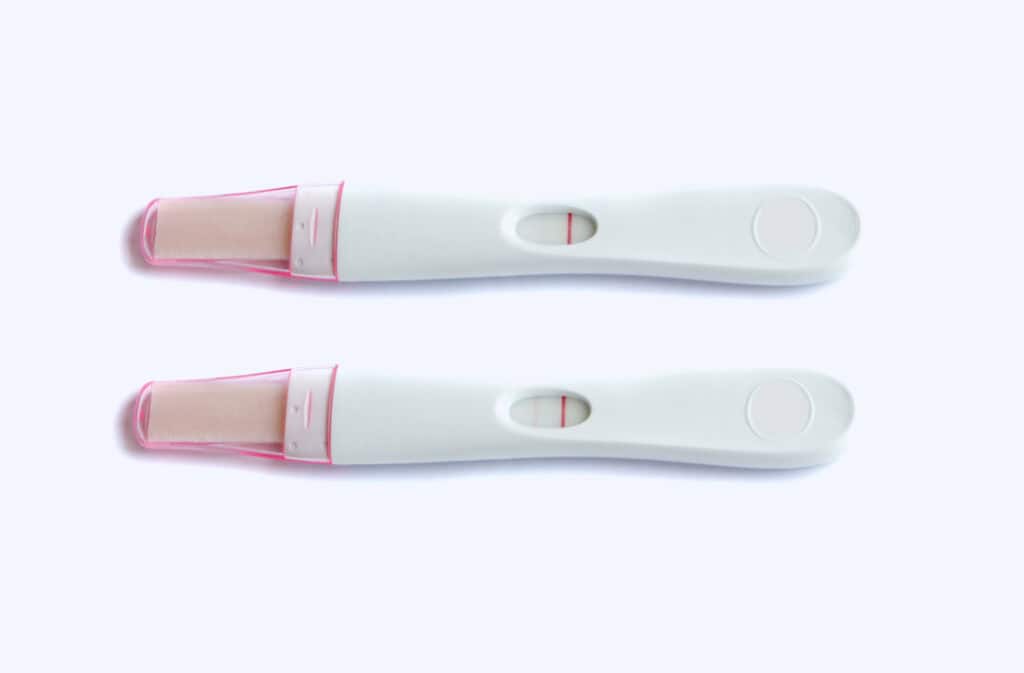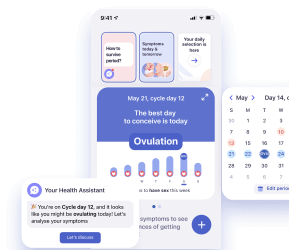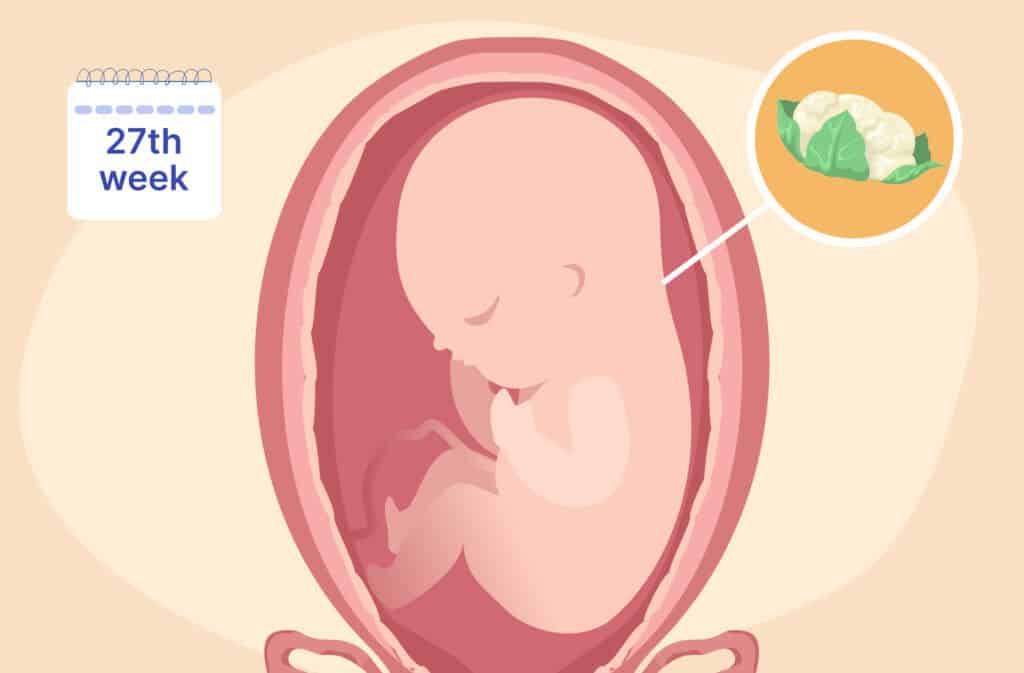Femia > Health Library > Getting Pregnant > Trying to conceive > Evaporation line vs. faint positive: How to tell the difference on your pregnancy test
Evaporation line vs. faint positive: How to tell the difference on your pregnancy test

- Updated Feb 24, 2025
- Published
CRAFTED BY HUMAN
Crafted by human At Femia, we provide accurate and up-to-date information at every stage of your journey, from trying to conceive, pregnancy and postnatal support. All content is created by a real person based on in-depth research and own professional experience. Femia ensures that you will receive expert advice, strict accuracy and a personalized approach from our authors/medical experts. Learn more about our editorial policy.
FACT CHECKED
Fact checked At Femia Health, we maintain the highest standards of editorial excellence in delivering content focused on helping you conceive, guiding you through pregnancy, and supporting you postpartum. Explore our content review principles to learn how we ensure the accuracy and quality of our health and lifestyle tips for every stage of your journey.

Created with Hector Chapa, MD, FACOG, Clinical associate professor, Obstetrics and Gynecology Texas A&M University, College of Medicine in Bryan-College Station, USA
- Faint positives on pregnancy tests appear within the reading window and are lightly colored, often indicating early pregnancy.
- Evaporation lines show up later and are colorless, just test artifacts.
- If unsure, retest in a few days using morning urine. Any colored line within the reading time usually means pregnancy, but when in doubt, consult your doctor.
If you’re trying to conceive (TTC), you’re probably closely tracking your menstrual cycle and ovulation window, and then spending the next two weeks waiting in excitement and anticipation. When it finally comes time to take your test, it’s only natural to be hoping to see a big fat positive (BFP).
But what if the second line on your test looks too faint?
Though these results aren’t uncommon, they frequently cause confusion and even anxiety in the TTC community, which is completely normal. A vague result might indicate a very faint positive pregnancy test or even just an evaporation line.
In this article, you’ll learn how to tell the difference between an evap line vs. faint positive so you can interpret your results correctly.

How pregnancy tests work
Pregnancy tests measure the level of human chorionic gonadotropin (hCG) from your body to tell whether you’re pregnant or not. hCG is a hormone created primarily by the syncytiotrophoblastic cells of the placenta and used to stimulate your body to produce progesterone to support the pregnancy, hence, elevated levels of hCG are a reliable indicator of conception.
In early pregnancy, syncytiotrophoblastic cells will produce hCG every day as its numbers build up in your body. The largest amount of hCG is catabolized by the liver, meaning that it breaks the complex hCG molecules into simple molecules. About 20% of hCG escapes the liver and leaves the body through the urine, hence why all over-the-counter pregnancy tests are performed using urine samples.
A home pregnancy test contains a reactive strip of paper to which you should apply the required amount of pee. The test should detect pregnancy within the timeframe specified in the instructions (timing may vary by brand) and display the result.
👉Find out more: Positive pregnancy test but no baby on ultrasound: What could it mean?
How much hCG does a person need for a positive pregnancy test?
The sensitivity of over-the-counter pregnancy tests ranges dramatically. The lower the indicator, the more sensitive and accurate the test is.
Laboratory studies of different test brands have shown the analytical sensitivity of First Response Early Result tests to be at 6.3 mIU/mL, detecting over 95% of pregnancies early—right on the day of the missed period. Another popular test type, Clearblue Easy Earliest Results, shows a sensitivity of 25 mIU/mL, a common sensitivity for over-the-counter tests that detects 80% of pregnancies. There are also tests with 100 mIU/mL sensitivity or greater, which can only detect 16% or less of pregnancies. Sselecting the right test with a high sensitivity level is your first step to ensuring an accurate result!
Despite the fluctuation in tests’ sensitivity, most over-the-counter tests should be able to detect pregnancy starting from the 25 mIU/mL hCG concentration. 25 is considered a fairly low concentration that will quickly build up during early weeks of pregnancy. In early pregnancy, your hCG levels will increase rapidly at this point. They usually double every 48 to 72 hours. So if you take additional tests a few days later, a faint line might turn darker over time.
👉Find out more: How long after sex does implantation occur: Understanding the timeline
What is an evaporation line?
In order to detect the difference between an evap vs. faint positive, it’s important to understand the definitions of both results.
Let’s start with an evaporation line. Also known as an evap line, it will apear as a slight, colorless streak in a your test’s result window as the urine evaporates from the reactive strip.
Finding a pregnancy test evaporation line isn’t uncommon. In most cases, it develops when you wait longer than the recommended time to read your test’s result. Seeing a barely noticeable line in your results might feel confusing. However, unlike a faint positive line, evap does not indicate pregnancy.
What is a faint positive?
A faint positive is a slight, faint line with color (usually pink or blue) that appears in the results window of your test. Unlike an evaporation line pregnancy test result, a faint positive line most often starts showing within the recommended test reading time.
The general rule of thumb is that if you see a positive line on a test within the suggested time, it’s a sign of pregnancy, no matter how faint it is.
The primary reasons that may cause you to find a very faint positive pregnancy test result include:
- A low level of hCG. This typically happens when you take a test while you’re very early into your pregnancy.
- A diluted urine sample. Urine samples are diluted when pregnancy tests are not performed first thing in the morning.

What to do if you see a faint line
Consider retesting in a couple of days. As the hCG levels rise, the color of the result line should darken, confirming your result.
If you have doubts, consider scheduling an appointment with your healthcare provider to reduce anxiety and get answers you can trust.
👉Find out more: Can an ovulation test detect pregnancy: Here’s what you may want to know
Evaporation line vs. faint positive: Key differences
There are three key distinctive features to keep in mind:
- Timing. A pregnancy test evaporation line typically appears past the recommended reading time (usually over 10 minutes) while a faint positive is revealed within the allotted time.
- Color. An evap line pregnancy test result doesn’t occur as a result of the reactive paper responding to hCG, which is why it’s typically colorless or gray. Faint positives, on the contrary, contain the test’s designated color eventhough they lack the brightness you would expect to see.
- Appearance. An evap line isn’t a part of the test, which is why it might look more streaky or uneven. Faint positives are solid, colored lines that appear pale or dull.

How to avoid misinterpreting a pregnancy test
If you’re trying to conceive, finding a colorless streak or a faint line on your test can easily induce anxiety. The differences described above should help you avoid unnecessary doubts and tell the difference between a faint line vs. evaporation line.
Here are a few extra tips that can help you avoid misinterpreting your test:
- Pick high-quality pregnancy tests with a high level of sensitivity.
- Read and follow the instructions, and interpret your test within the suggested time.
- If still unsure about your results, consider taking a follow-up test in a few days.
Questions from the Femia community
Are some of the pregnancy tests I'm using more likely to show those confusing evap lines?
Yes, different brands might differ both in sensitivity and quality. Hence, some cheaper options might be more prone to showing evaporation lines or might even be incapable of detecting early pregnancy. It’s always best to choose high-quality tests and follow the instructions carefully.
Will I get a clearer result if I take my pregnancy test at a specific time?
Yes. In the early morning, your urine is most concentrated. If you have your test ready to go first thing when you wake up, you increase your chances for an accurate result and a clearer line.
Could my really light positive test be because of a chemical pregnancy?
Yes, it’s positive. A chemical pregnancy implies an early pregnancy that takes place soon after implantation. By this time, your body has already started producing hCG, which can cause a faint positive result that will turn into a negative a few weeks later.
The bottom line
So how do you tell the difference between a faint positive pregnancy test vs evaporation line?
These results can look quite similar and cause confusion if you’re trying to conceive. However, there are three things that distinguish them:
- The timing when they appear on the test;
- Their color;
- Their overall appearance.
Typically, a faint positive appears readily (within the recommended test reading time) and can be distinguished by the test’s designated color. It might indicate an early pregnancy when your hCG levels are still fairly low.
The tips we’ve shared with you in this guide should help you detect what kind of result you’re seeing and avoid misinterpreting your test. Remember to pick quality tests and follow their instructions cosely to acheive as accurate a reading as possible. If you’re still not 100% sure what result you got, consider taking a follow-up test in a few days, or consult your doctor.
References
- Betz D, Fane K. “Human Chorionic Gonadotropin.” StatPearls, National Library of Medicine, 14, Aug. 2023. https://www.ncbi.nlm.nih.gov/books/NBK532950/#:~:text=Human%20chorionic%20gonadotropin%20is%20a,the%20liver%2C%20and%20the%20colon.
- “Pregnancy Tests.” Cleveland Clinic, 28, Nov. 2022. https://my.clevelandclinic.org/health/diagnostics/9703-pregnancy-tests.
- Cole LA, Sutton-Riley JM, Khanlian SA, Borkovskaya M, Rayburn BB, Rayburn WF. “Sensitivity of over-the-counter pregnancy tests: comparison of utility and marketing messages.” J Am Pharm Assoc (2003), Sep-Oct. 2005. https://pubmed.ncbi.nlm.nih.gov/16295647/.
- Nepomnaschy PA, Weinberg CR, Wilcox AJ, Baird DD. “Urinary hCG patterns during the week following implantation.” Hum Reprod, Feb. 2008. https://pubmed.ncbi.nlm.nih.gov/18083748/.

Discover what happens at 27 weeks pregnant, from baby’s development and size to belly changes and self-care tips for managing symptoms.

First-time sex tips: how to have sex for the first time confidently and the best poses for comfort and pleasure. Essential advice for a relaxed and enjoyable experience.

Learn the best times to have sex during ovulation to maximize your chances. Discover expert tips and methods to help you identify your fertile window.
